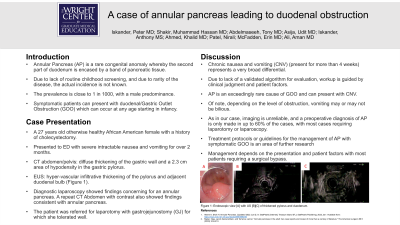Sunday Poster Session
Category: Biliary/Pancreas
P0152 - A Case of Annular Pancreas Leading to Duodenal Obstruction
Sunday, October 22, 2023
3:30 PM - 7:00 PM PT
Location: Exhibit Hall

Has Audio

Peter Iskander, MD
The Wright Center for GME
Dunmore, PA
Presenting Author(s)
Peter Iskander, MD1, Muhammad Shakir, MD2, Tony Abdelmaseeh, MD2, Udit Asija, MD2, Anthony Iskander, 3, Khalid Ahmed, MD2, Nirali Patel, MD2, Erin McFadden, MD2, Aman Ali, MD4
1The Wright Center for GME, Dunmore, PA; 2The Wright Center for GME, Scranton, PA; 3Xavier University School of Medicine, Oranjestad, Aruba; 4Wilkes-Barre General Hospital, Scranton, PA
Introduction: Annular Pancreas (AP) is a rare congenital anomaly whereby the second part of duodenum is encased by a band of pancreatic tissue. Due to lack of routine childhood screening and due to rarity of the disease, the actual incidence is not known. The prevalence is close to 1 in 1000, with a male predominance. Symptomatic patients can present with duodenal/Gastric Outlet Obstruction (GOO) which can occur at any age starting in infancy.
Case Description/Methods: A 27 years old otherwise healthy African American female with a history of cholecystectomy presented to the ED with severe intractable nausea and vomiting for over 2 months. CT abdomen/pelvis with contrast showed diffuse thickening of the gastric wall and a 2.3 cm area of hypodensity in the gastric pylorus. She was discharged on oral PPIs with advice to follow with GI. Upper endoscopy with endoscopic ultrasound (EUS) was later done which showed a hypervascular infiltrative thickening of the pylorus and adjacent duodenal bulb (Figure 1). Pyloric and duodenal biopsies were taken but were all unrevealing. Percutaneous peritoneal biopsies around the duodenum were also unrevealing. Finally, a diagnostic laparoscopy was planned that showed findings concerning for an annular pancreas. A repeat CT Abdomen with contrast also showed findings consistent with annular pancreas. The patient was referred for laparotomy with gastrojejunostomy (GJ) for which she tolerated well.
Discussion: Chronic nausea and vomiting (CNV) (present for more than 4 weeks) represents a very broad differential. Due to lack of a validated algorithm for evaluation, workup is guided by clinical judgment and patient factors. AP is an exceedingly rare cause of GOO and can present with CNV. Of note, depending on the level of obstruction, vomiting may or may not be bilious. As in our case, imaging is unreliable, and a preoperative diagnosis of AP is only made in up to 60% of the cases, with most cases requiring laparotomy or laparoscopy. Treatment protocols or guidelines for the management of AP with symptomatic GOO is an area of further research; management depends on the presentation and patient factors with most patients requiring a surgical bypass.

Disclosures:
Peter Iskander, MD1, Muhammad Shakir, MD2, Tony Abdelmaseeh, MD2, Udit Asija, MD2, Anthony Iskander, 3, Khalid Ahmed, MD2, Nirali Patel, MD2, Erin McFadden, MD2, Aman Ali, MD4. P0152 - A Case of Annular Pancreas Leading to Duodenal Obstruction, ACG 2023 Annual Scientific Meeting Abstracts. Vancouver, BC, Canada: American College of Gastroenterology.
1The Wright Center for GME, Dunmore, PA; 2The Wright Center for GME, Scranton, PA; 3Xavier University School of Medicine, Oranjestad, Aruba; 4Wilkes-Barre General Hospital, Scranton, PA
Introduction: Annular Pancreas (AP) is a rare congenital anomaly whereby the second part of duodenum is encased by a band of pancreatic tissue. Due to lack of routine childhood screening and due to rarity of the disease, the actual incidence is not known. The prevalence is close to 1 in 1000, with a male predominance. Symptomatic patients can present with duodenal/Gastric Outlet Obstruction (GOO) which can occur at any age starting in infancy.
Case Description/Methods: A 27 years old otherwise healthy African American female with a history of cholecystectomy presented to the ED with severe intractable nausea and vomiting for over 2 months. CT abdomen/pelvis with contrast showed diffuse thickening of the gastric wall and a 2.3 cm area of hypodensity in the gastric pylorus. She was discharged on oral PPIs with advice to follow with GI. Upper endoscopy with endoscopic ultrasound (EUS) was later done which showed a hypervascular infiltrative thickening of the pylorus and adjacent duodenal bulb (Figure 1). Pyloric and duodenal biopsies were taken but were all unrevealing. Percutaneous peritoneal biopsies around the duodenum were also unrevealing. Finally, a diagnostic laparoscopy was planned that showed findings concerning for an annular pancreas. A repeat CT Abdomen with contrast also showed findings consistent with annular pancreas. The patient was referred for laparotomy with gastrojejunostomy (GJ) for which she tolerated well.
Discussion: Chronic nausea and vomiting (CNV) (present for more than 4 weeks) represents a very broad differential. Due to lack of a validated algorithm for evaluation, workup is guided by clinical judgment and patient factors. AP is an exceedingly rare cause of GOO and can present with CNV. Of note, depending on the level of obstruction, vomiting may or may not be bilious. As in our case, imaging is unreliable, and a preoperative diagnosis of AP is only made in up to 60% of the cases, with most cases requiring laparotomy or laparoscopy. Treatment protocols or guidelines for the management of AP with symptomatic GOO is an area of further research; management depends on the presentation and patient factors with most patients requiring a surgical bypass.

Figure: Figure 1: Endoscopic view [A] with US [B][C] of thickened pylorus and duodenum.
Disclosures:
Peter Iskander indicated no relevant financial relationships.
Muhammad Shakir indicated no relevant financial relationships.
Tony Abdelmaseeh indicated no relevant financial relationships.
Udit Asija indicated no relevant financial relationships.
Anthony Iskander indicated no relevant financial relationships.
Khalid Ahmed indicated no relevant financial relationships.
Nirali Patel indicated no relevant financial relationships.
Erin McFadden indicated no relevant financial relationships.
Aman Ali indicated no relevant financial relationships.
Peter Iskander, MD1, Muhammad Shakir, MD2, Tony Abdelmaseeh, MD2, Udit Asija, MD2, Anthony Iskander, 3, Khalid Ahmed, MD2, Nirali Patel, MD2, Erin McFadden, MD2, Aman Ali, MD4. P0152 - A Case of Annular Pancreas Leading to Duodenal Obstruction, ACG 2023 Annual Scientific Meeting Abstracts. Vancouver, BC, Canada: American College of Gastroenterology.
